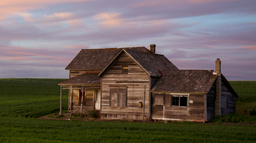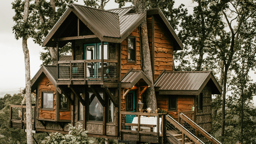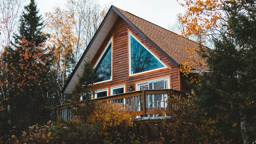"The secret to preventing weeds is to cover the soil with vegetation to prevent sunlight from reaching the soil and encouraging weed seeds to grow,” says landscape architect Patrick Devereux, co-owner of Stone Oak Landscapes in Cudahy, Wis. To minimize your time digging out weeds so you can recline on the deck and dig into the newest best-selling novel instead, all you need is a sound game plan.
Plan ahead to reduce weeds
Whether you’ve just dug up the planting beds near your cabin’s foundation so you can start with a fresh palette, or you’re planning a new bed, Devereux recommends selecting cultivars that grow closely together and get dense foliage so you don’t have a lot of mulch or bare soil between the plants.
You don’t have to stick with just one type of plant to create these solid groupings; using a variety will add visual interest. You’ll also want to consider using plants that grow to varying heights to create an appealing layered look.
For a first layer, Devereux likes to use Canadian wild ginger (Asarum canadense) and periwinkle (Vinca minor), two low-growing plants that fill in and minimize weeds. Other great options are shrubs or evergreens that spread as ground cover, like juniper (try Juniperus sabina or J. chinensis), which is available in several varieties.
To find out which plants are right for your hardiness zone, talk to a local landscape architect or designer, an expert at your local garden center, or your local county extension office.
Also, be strategic about where you place bird (and, let’s face it, squirrel and raccoon) feeders. Typically, weed seeds get spread by animals when they leave their droppings. So, instead of installing your new feeder in the middle of your perennial garden, consider siting it in a more open area where it’ll be easier for you to pull or hoe weeds.
Simplify lawn care
Devereux offers tricks for reducing weeds in your lawn as well. For starters, many people cut their grass too short, allowing sunlight to reach the soil. He recommends that you keep the grass 3–31⁄2 inches tall to shade the soil. Eco bonus: Letting the grass grow longer reduces fuel consumption.
And because a manicured look requires more maintenance, drifting toward an au naturel mentality for your lawn will maximize free time as well. For areas farther from the cabin, consider cultivating a meadow or prairie look.
“We’ll use a meadow planting to landscape larger swaths of land in a large yard,” says Devereux. He likes to use low-mow, low-grow seed mixtures that sprout grass that grows about 9 inches tall and only needs to be cut about once a year. Still, he says, it’s important to mow prairies at the appropriate time of year.
To ornament hills and slopes while preventing erosion, Devereux plants Grow-low sumac (Rhus aromatica), because it propagates wherever the branches touch the ground.
Cabin owners in arid or semi-arid climates, he notes, may take advantage of xeriscaping, a landscaping method that focuses on water-conserving techniques. Check with local nurseries to see what plants in your region are drought-tolerant.
The myth of the cure-all landscape fabric
For years, landscape fabric has enjoyed popularity as the go-to for weed prevention. The theory is that landscape fabric laid over soil and topped with a pretty layer of mulch will keep weeds from growing in flower beds, but some experts are concluding that nature’s a bit more clever than that.
Mulch is an organic material that decomposes. When that happens, it creates what is, essentially, a new layer of soil. If weed seeds fall into the mulch layer, they’ll grow there. And if weeds grow through your layers of mulch, landscape fabric and soil, they’re much more difficult to remove because they’re nicely anchored in there.
Devereux uses landscape fabric only under stone mulches, which he tends to locate under eaves that don’t have gutters (to prevent dirt from splashing onto a home’s foundation) or under shaded areas, like decks, where most plants won’t grow.
When clients ask him to incorporate plants with stone mulches, he picks “bullet-proof” plants like Gro-low sumac, spirea, and daylily. Such hardy plants tolerate a range of soil conditions, light requirements, and water conditions – important because the stone heats up and reflects light onto the plants.
If you decide to use plants with landscape fabric and stone mulch, Devereux recommends that you cut large holes in the fabric around these plants because the fabric tends to hold moisture in the soil and rot the plant roots. “But,” he says, “weeds will still grow in gravel mulch – just look at cracks in sidewalks, on the interstate, in asphalt driveways …”
If you’re going to use a landscape mat, keep in mind that plastic is the hardest on the soil and your plants because it doesn’t allow for oxygen or water exchange.
Weeding tips
Before you take the time to rid your yard of an unknown cultivar, use a good book to find out what it is, whether you need to get rid of it, and how to do it. In general, Devereux recommends that you get rid of weeds when they’re small by simply using a hoe or shovel to remove them from the ground and chop them up (you don’t even have to take them out of the flower bed). For further advice, your local extension agent and university are great resources.
Kristin Sutter loves digging in the dirt and got her fix as a kid by helping her dad plant potatoes in the garden. Later, she honed her disappearing skills come weeding time.
Plan ahead to reduce weeds
Whether you’ve just dug up the planting beds near your cabin’s foundation so you can start with a fresh palette, or you’re planning a new bed, Devereux recommends selecting cultivars that grow closely together and get dense foliage so you don’t have a lot of mulch or bare soil between the plants.
You don’t have to stick with just one type of plant to create these solid groupings; using a variety will add visual interest. You’ll also want to consider using plants that grow to varying heights to create an appealing layered look.
For a first layer, Devereux likes to use Canadian wild ginger (Asarum canadense) and periwinkle (Vinca minor), two low-growing plants that fill in and minimize weeds. Other great options are shrubs or evergreens that spread as ground cover, like juniper (try Juniperus sabina or J. chinensis), which is available in several varieties.
To find out which plants are right for your hardiness zone, talk to a local landscape architect or designer, an expert at your local garden center, or your local county extension office.
Also, be strategic about where you place bird (and, let’s face it, squirrel and raccoon) feeders. Typically, weed seeds get spread by animals when they leave their droppings. So, instead of installing your new feeder in the middle of your perennial garden, consider siting it in a more open area where it’ll be easier for you to pull or hoe weeds.
Simplify lawn care
Devereux offers tricks for reducing weeds in your lawn as well. For starters, many people cut their grass too short, allowing sunlight to reach the soil. He recommends that you keep the grass 3–31⁄2 inches tall to shade the soil. Eco bonus: Letting the grass grow longer reduces fuel consumption.
And because a manicured look requires more maintenance, drifting toward an au naturel mentality for your lawn will maximize free time as well. For areas farther from the cabin, consider cultivating a meadow or prairie look.
“We’ll use a meadow planting to landscape larger swaths of land in a large yard,” says Devereux. He likes to use low-mow, low-grow seed mixtures that sprout grass that grows about 9 inches tall and only needs to be cut about once a year. Still, he says, it’s important to mow prairies at the appropriate time of year.
To ornament hills and slopes while preventing erosion, Devereux plants Grow-low sumac (Rhus aromatica), because it propagates wherever the branches touch the ground.
Cabin owners in arid or semi-arid climates, he notes, may take advantage of xeriscaping, a landscaping method that focuses on water-conserving techniques. Check with local nurseries to see what plants in your region are drought-tolerant.
The myth of the cure-all landscape fabric
For years, landscape fabric has enjoyed popularity as the go-to for weed prevention. The theory is that landscape fabric laid over soil and topped with a pretty layer of mulch will keep weeds from growing in flower beds, but some experts are concluding that nature’s a bit more clever than that.
Mulch is an organic material that decomposes. When that happens, it creates what is, essentially, a new layer of soil. If weed seeds fall into the mulch layer, they’ll grow there. And if weeds grow through your layers of mulch, landscape fabric and soil, they’re much more difficult to remove because they’re nicely anchored in there.
Devereux uses landscape fabric only under stone mulches, which he tends to locate under eaves that don’t have gutters (to prevent dirt from splashing onto a home’s foundation) or under shaded areas, like decks, where most plants won’t grow.
When clients ask him to incorporate plants with stone mulches, he picks “bullet-proof” plants like Gro-low sumac, spirea, and daylily. Such hardy plants tolerate a range of soil conditions, light requirements, and water conditions – important because the stone heats up and reflects light onto the plants.
If you decide to use plants with landscape fabric and stone mulch, Devereux recommends that you cut large holes in the fabric around these plants because the fabric tends to hold moisture in the soil and rot the plant roots. “But,” he says, “weeds will still grow in gravel mulch – just look at cracks in sidewalks, on the interstate, in asphalt driveways …”
If you’re going to use a landscape mat, keep in mind that plastic is the hardest on the soil and your plants because it doesn’t allow for oxygen or water exchange.
Weeding tips
Before you take the time to rid your yard of an unknown cultivar, use a good book to find out what it is, whether you need to get rid of it, and how to do it. In general, Devereux recommends that you get rid of weeds when they’re small by simply using a hoe or shovel to remove them from the ground and chop them up (you don’t even have to take them out of the flower bed). For further advice, your local extension agent and university are great resources.
Kristin Sutter loves digging in the dirt and got her fix as a kid by helping her dad plant potatoes in the garden. Later, she honed her disappearing skills come weeding time.
BOOKS THAT ID WEEDS
"Invasive Plants" by Sylvan Ramsey Kaufman and Wallace Kaufman, Stackpole Books, $39.95, www.stackpolebooks.com
"Color Atlas of Turfgrass Weeds, 2nd Edition" by L. B. McCarty, John W. Everest, David W. Hall, Tim R. Murphy and Fred Yelverton, Wiley publishers, $145, www.wiley.com
"Weeds of the Northeast" by Richard H. Uva, Joseph C. Neal and Joseph M. Ditomaso, Cornell University Press, $29.95, www.cornellpress.cornell.edu
"Invasive Plants" by Sylvan Ramsey Kaufman and Wallace Kaufman, Stackpole Books, $39.95, www.stackpolebooks.com
"Color Atlas of Turfgrass Weeds, 2nd Edition" by L. B. McCarty, John W. Everest, David W. Hall, Tim R. Murphy and Fred Yelverton, Wiley publishers, $145, www.wiley.com
"Weeds of the Northeast" by Richard H. Uva, Joseph C. Neal and Joseph M. Ditomaso, Cornell University Press, $29.95, www.cornellpress.cornell.edu














